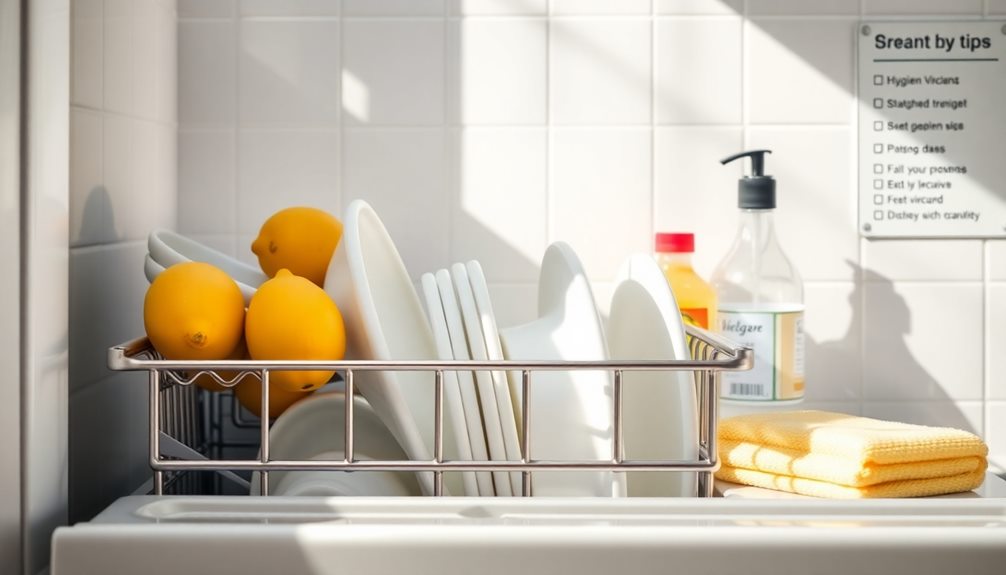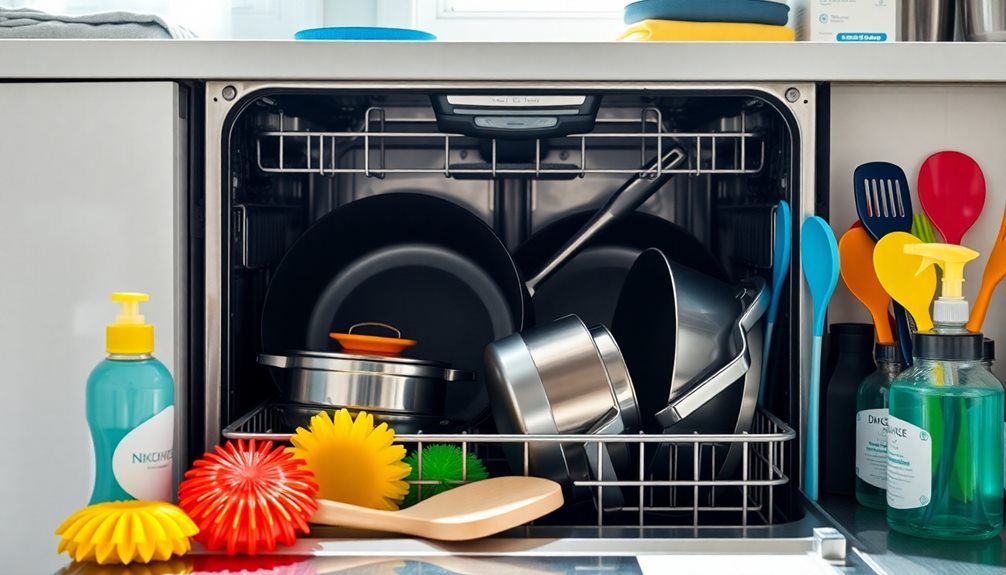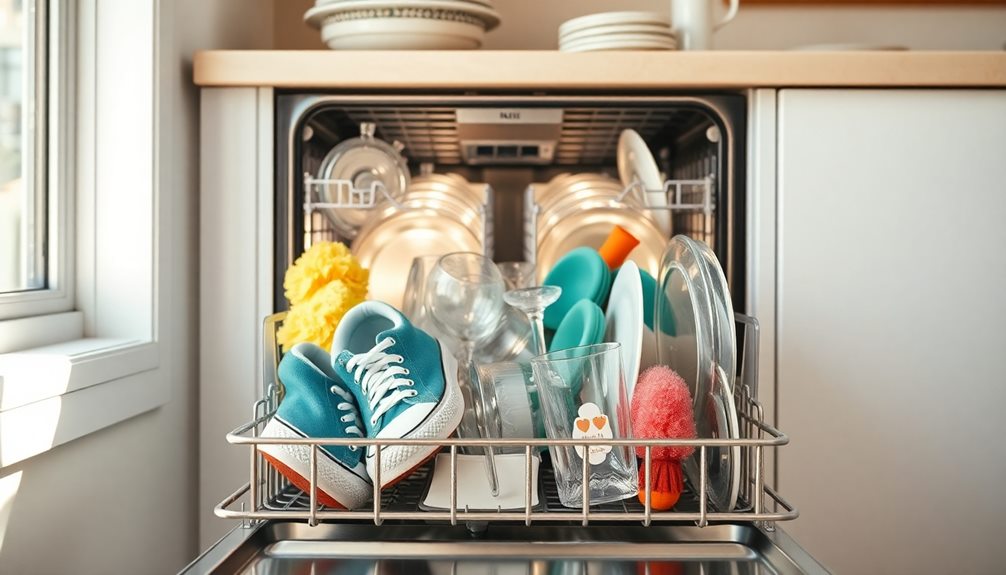You might not realize how many genius dishwasher hacks can streamline your dishwashing process. Start by organizing your dishes in the sink, and wash the cleanest items first to avoid grease transfer. Invest in essential tools, like a stainless steel sink caddy and a double-sided silverware cleaning brush. Maintain hygiene by regularly sanitizing your sponges and brushes. Don't forget to hand wash delicate items like sharp knives and crystal. Use higher fat content butters for nonstick cookware to keep them in great shape. There's much more to discover that can enhance your kitchen efficiency!
Key Takeaways
- Organize dishes in the sink before washing to streamline the dishwashing process and reduce clutter.
- Use Dawn foaming soap for more powerful cleaning, effectively tackling tough grease and grime.
- Regularly clean and sanitize sponges and dish brushes to prevent bacteria buildup and cross-contamination.
- Hand wash delicate items like crystal and wooden utensils to ensure they remain undamaged.
- Utilize vertical storage solutions for cookware to minimize scratches and enhance kitchen organization.
Efficient Dishwashing Preparation
To make your dishwashing routine more efficient, start by organizing your dishes before you even turn on the water. Stack your plates and bowls neatly in the sink to keep everything in order. This efficient dishwashing preparation is key to speeding up the process.
Begin by washing the cleanest items first—like glasses and cups—before tackling the more challenging pots and pans. This method minimizes grease transfer and cross-contamination, keeping your dishes cleaner.
While cooking, clean as you go. This not only reduces the buildup of dirty dishes but also makes your post-cooking cleanup a breeze. Additionally, sort your silverware into a cup to keep it together; it makes washing easier and more efficient.
Gather all necessary tools—like sponges, brushes, and dish soap—before diving into the washing process. Using the right tools guarantees a smoother and more organized experience.
Essential Dishwashing Tools

Having the right tools can make all the difference in your dishwashing routine. One essential dishwashing tool is a stainless steel sink caddy. It helps you organize your brushes and sponges while being made from rust-proof material, guaranteeing durability.
To tackle tough grease and grime, opt for Dawn foaming soap; it's five times more powerful than regular liquid soap, making it a game-changer for your cleaning efforts.
Another handy tool is a double-sided silverware cleaning brush. This tool simplifies the cleaning process, allowing you to effectively reach both sides of your utensils for a thorough wash.
To make sure your dishwashing tools remain effective, it's vital to regularly clean and sanitize them. This practice helps prevent cross-contamination and maintains hygiene.
Lastly, consider a glass refillable foam dispenser. It not only adds a touch of aesthetic appeal to your sink area but also promotes cost-effectiveness by reducing waste from disposable soap containers.
Maintaining Hygiene Standards

Maintaining hygiene standards in your dishwashing routine is vital for preventing the spread of bacteria. Start by regularly cleaning your sponges and dish brushes. Sponges can trap moisture and harbor bacteria, while dish brushes are less likely to do so.
To keep your dish brushes disinfected, soak them in distilled white vinegar for 1-2 hours. This effective method helps prevent cross-contamination during your hand washing. Additionally, confirming that your pets are safe from toxic substances like certain flowers can also contribute to a healthier home environment.
When it comes to drying your dishes, air drying is the way to go. It's more sanitary than using kitchen towels, which can transfer bacteria back onto your clean items.
Don't forget to maintain your sink's hygiene, too. Utilize a specialized sink cleaning brush to minimize bacterial spread to your dishes.
Consistently sanitizing your dishwashing tools is essential. Keep them organized in a stainless steel sink caddy for easy access and to further reduce the risk of cross-contamination.
Caring for Special Cookware

While keeping your kitchen tools hygienic is important, caring for special cookware is just as vital to preserve their quality and longevity. You want to make sure that your beloved items last, so take the time to clean them right away and avoid the dishwasher.
Additionally, ensuring your cookware is free from bacteria and contaminants can help promote overall health, much like maintaining good dental hygiene is essential for preventing oral health issues.
Here are some tips to help you care for your special cookware:
- Always hand wash sharp knives to maintain their sharpness and avoid dulling the blades.
- For cast iron skillets, clean them immediately while they're warm and skip the soap to keep the seasoning intact.
- Crystal and wooden utensils require gentle hand washing to prevent deterioration over time.
Don't forget about insulated tumblers like BruMate mugs; those should also be hand washed to prevent damage from the dishwasher's heat and pressure. If you see a "hand wash only" label, take it seriously and treat those items with care.
Nonstick Cookware Tips

When it comes to nonstick cookware, using the right cleaning techniques is essential to keep it in top shape.
You should also consider how you store your pans, as improper stacking can lead to scratches that ruin the nonstick surface.
Let's explore some safe cleaning methods and proper storage tips to extend the life of your favorite cookware.
Safe Cleaning Techniques
Safety is paramount in the kitchen, especially when it comes to cleaning nonstick cookware. Using the right techniques not only guarantees your safety but can also save you money by prolonging the life of your pans.
Here are some essential tips: Consider using higher fat content butters as they can enhance your cooking process while also being gentle on your nonstick surfaces. Avoid nonstick cookware treated with Teflon and PTFE chemicals.
Clean pots and pans immediately after use to prevent stubborn residue. Use oils with high smoke points, like avocado oil, to protect your cookware.
When dealing with burnt food, don't panic! Simply boil water in the pan, add two tablespoons of baking soda, and let it work its magic to loosen stubborn residue.
Opting for high-quality alternatives like GreenPan can further enhance your cooking experience while maintaining safety.
Proper Storage Methods
To keep your nonstick cookware in top shape, proper storage methods are crucial.
Begin by avoiding the temptation to stack pots and pans directly on top of each other. Instead, use soft materials like towels or cloths between them. This simple job cleaning can prevent scratches, which degrade the nonstick coating over time.
Consider investing in dedicated storage solutions such as pot racks or cabinet organizers. These can help keep your cookware accessible while minimizing wear and tear. If you must stack your nonstick pans, always place a cloth or paper towel between them. This extra layer of protection will help maintain their nonstick properties and extend their lifespan.
Organizing your cookware is key. Arrange them in a way that prevents contact between surfaces, which greatly reduces the risk of damage.
Remember, the better you store your nonstick cookware, the longer it will last and perform effectively. By taking these precautions, you'll guarantee your nonstick pieces remain in excellent condition, making your cooking experience that much more enjoyable.
It's all about creating a storage environment that prioritizes the longevity of your beloved cookware.
Smart Cookware Storage Solutions

When it comes to storing your cookware, using vertical storage techniques can save space and keep everything accessible.
You can also protect your pots and pans with padding to prevent scratches and damage.
These smart solutions not only organize your kitchen but help extend the life of your essentials.
Vertical Storage Techniques
Maximizing space in your kitchen can elevate both functionality and organization. By adopting vertical storage techniques for your cookware, you can save much time and effort while keeping your kitchen neat. Here are some smart ideas to get you started:
- Use pan racks or wall-mounted shelves to store pots and pans, preventing scratches and damage to nonstick coatings.
- Install cabinet organizers or pull-out shelves for easy access to frequently used items, eliminating the need to dig through clutter.
- Leverage magnetic strips or hooks to hang lids vertically, creating more space and keeping everything within reach.
These solutions not only enhance your kitchen's organization but also prolong the lifespan of your cookware. Instead of stacking pots and pans—which can degrade their protective coatings—use dividers or towels between each piece.
Additionally, dedicated storage options like tiered racks for baking sheets and cutting boards help keep everything tidy. With these vertical storage techniques, you'll find it much easier to locate and retrieve your cooking essentials, making your kitchen experience smoother and more enjoyable.
Protective Padding Methods
Over time, improper storage can lead to scratches and damage to your cookware, which is why using protective padding methods is essential. Start by investing in towels or pan racks when stacking your pots and pans. Stacking without protection can degrade coatings over time, making your cookware less prone to wear.
Consider using felt or silicone liners between stacked items to create a protective barrier. This helps maintain the integrity of nonstick surfaces and other delicate finishes, ensuring they stay in top shape.
Additionally, storing your cookware vertically in dedicated storage solutions minimizes contact, which can prevent scratches and prolong the lifespan of your kitchen tools.
Organizing your cookware by size and type not only reduces clutter but also allows for easier access, minimizing the risk of damaging surfaces during retrieval. Properly spacing your cookware in cabinets can help avoid chipping and scratches, ensuring that each piece remains in good condition for longer.
Frequently Asked Questions
How Can I Prevent My Dishes From Sticking Together in the Dishwasher?
To prevent your dishes from sticking together in the dishwasher, make sure you load them properly, allowing enough space between items. You can also try using a rinse aid to help reduce moisture and sticking.
What Is the Best Way to Load Glasses to Avoid Breakage?
To avoid breaking glasses in the dishwasher, you're better off placing them on the top rack, ensuring they're secured between tines. Don't let them touch each other, and avoid overloading the dishwasher.
Can I Wash Plastic Containers in the Dishwasher Safely?
Yes, you can wash plastic containers in the dishwasher safely. Just make sure they're labeled as dishwasher-safe, and place them on the top rack to avoid warping from the heat of the bottom.
How Do I Remove Odors From My Dishwasher?
To tackle odors, you could think your dishwasher's just dirty, but it might be food residue or mold. Try running it empty with vinegar or baking soda; it'll freshen things up and eliminate lingering smells effectively.
Is It Safe to Run the Dishwasher While I'm Not Home?
Yes, it's generally safe to run your dishwasher while you're not home. Just make sure it's in good condition, and avoid overloading it. Always check for leaks or issues before leaving. Stay worry-free!
Conclusion
By embracing these genius dishwasher hacks, you'll not only streamline your dishwashing routine but also extend the life of your cookware. Did you know that nearly 70% of households use their dishwashers inefficiently, wasting both time and energy? With the right tools and techniques, you can save money and resources while keeping your kitchen spick and span. So, start implementing these tips today, and you'll wonder how you ever lived without them!










